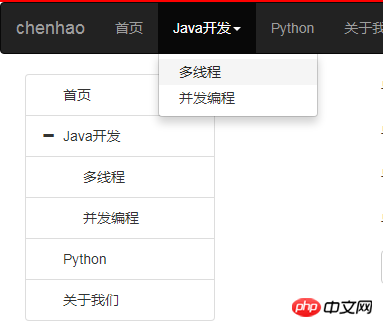
This article mainly introduces the example code for building a tree menu in Java (supporting multi-level menus). It is very good and has reference value. Friends in need can refer to the
renderings: support multi-level menus menu.

Menu entity class:
public class Menu {
// 菜单id
private String id;
// 菜单名称
private String name;
// 父菜单id
private String parentId;
// 菜单url
private String url;
// 菜单图标
private String icon;
// 菜单顺序
private int order;
// 子菜单
private List<Menu> children;
// ... 省去getter和setter方法以及toString方法
}Menus generally need to be sorted, we sort according to the order field of Menu:
/*
* 排序,根据order排序
*/
public Comparator<Menu> order(){
Comparator<Menu> comparator = new Comparator<Menu>() {
@Override
public int compare(Menu o1, Menu o2) {
if(o1.getOrder() != o2.getOrder()){
return o1.getOrder() - o2.getOrder();
}
return 0;
}
};
return comparator;
}Method to generate tree:
public Map<String,Object> findTree(){
Map<String,Object> data = new HashMap<String,Object>();
try {//查询所有菜单
List<Menu> allMenu = menuDao.findTree();
//根节点
List<Menu> rootMenu = new ArrayList<Menu>();
for (Menu nav : allMenu) {
if(nav.getParentId().equals("0")){//父节点是0的,为根节点。
rootMenu.add(nav);
}
}
/* 根据Menu类的order排序 */
Collections.sort(rootMenu, order());
//为根菜单设置子菜单,getClild是递归调用的
for (Menu nav : rootMenu) {
/* 获取根节点下的所有子节点 使用getChild方法*/
List<Menu> childList = getChild(nav.getId(), allMenu);
nav.setChildren(childList);//给根节点设置子节点
}
/**
* 输出构建好的菜单数据。
*
*/
data.put("success", "true");
data.put("list", rootMenu);
return data;
} catch (Exception e) {
data.put("success", "false");
data.put("list", new ArrayList());
return data;
}
}Get submenu:
/**
* 获取子节点
* @param id 父节点id
* @param allMenu 所有菜单列表
* @return 每个根节点下,所有子菜单列表
*/
public List<Menu> getChild(String id,List<Menu> allMenu){
//子菜单
List<Menu> childList = new ArrayList<Menu>();
for (Menu nav : allMenu) {
// 遍历所有节点,将所有菜单的父id与传过来的根节点的id比较
//相等说明:为该根节点的子节点。
if(nav.ParentId().equals(id)){
childList.add(nav);
}
}
//递归
for (Menu nav : childList) {
nav.setChildren(getChild(nav.getId(), allMenu));
}
Collections.sort(childList,order());//排序
//如果节点下没有子节点,返回一个空List(递归退出)
if(childList.size() == 0){
return new ArrayList<Menu>();
}
return childList;
}The final returned JSON string is as follows:
{
"success": "true",
"list": [
{
"id": "1",
"name": "Java",
"parentid": "0",
"url": "http://www.aliouchen.com",
"order": 1,
"children": [
{
"id": "2",
"name": "并发编程",
"parentid": "1",
"url": "http://www.aliouchen.com",
"order": 1,
"children": []
},
{
"id": "3",
"name": "多线程",
"parentid": "1",
"url": "http://www.aliouchen.com",
"order": 2,
"children": [
"id": "4",
"name": "Thread",
"parentid": "3",
"url": "http://www.aliouchen.com",
"order": 1,
"children":[]
]
}
]
},
{
"id": "5",
"name": "Python",
"parentid": "0",
"url": "http://www.aliouchen.com",
"order": 2,
"children": []
}
]
}Summary
The above is the detailed content of Example code for building tree menus and supporting multi-level menus in Java. For more information, please follow other related articles on the PHP Chinese website!




